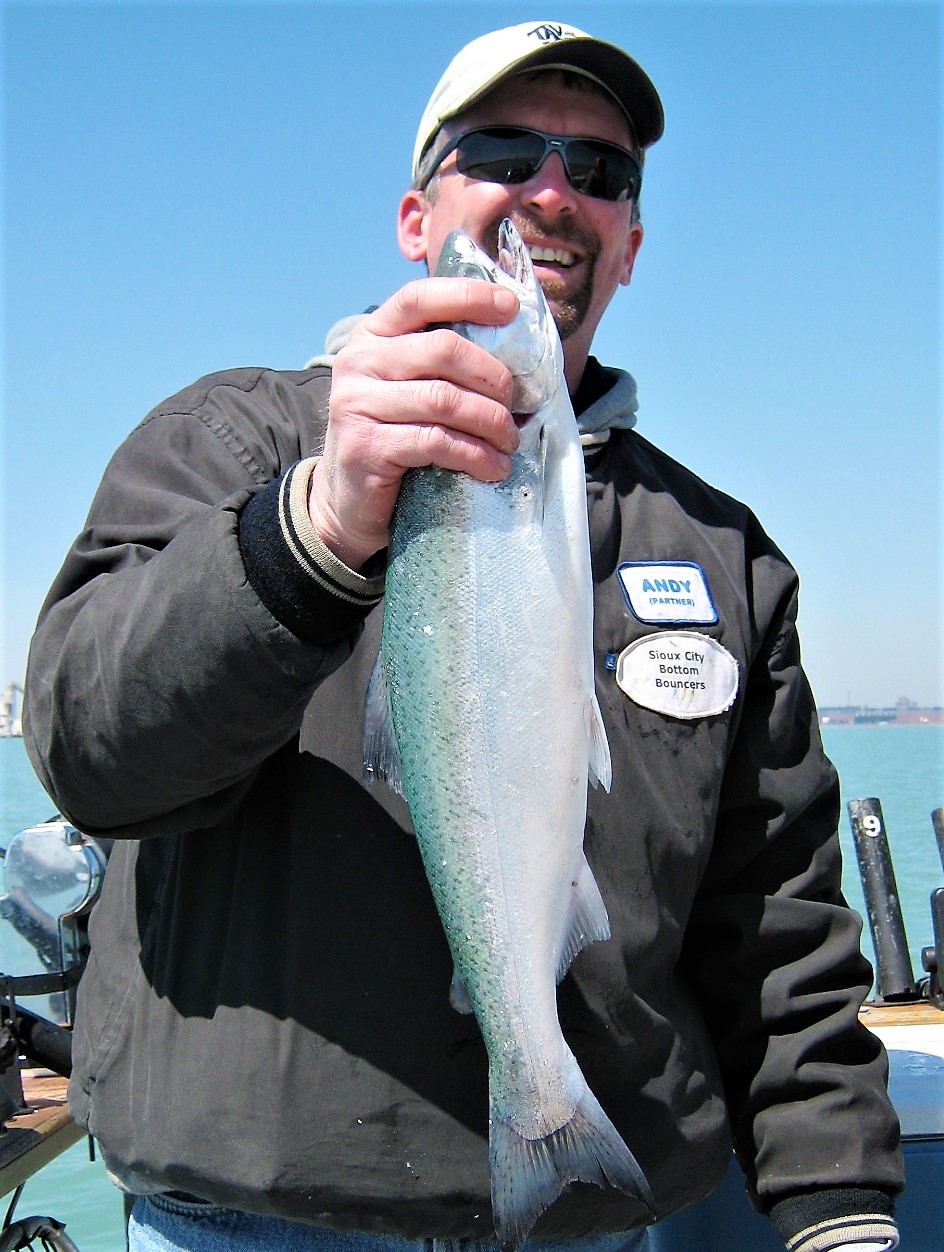
Bob Holzhei and first mate, Justin Grubaugh, admire the size of one of our lake trout.By Bob Holzhei
Lake Trout were targeted on this fishing trip and it wasn’t long before the first fish was boated. It was caught on a Monkey Fish lure. Then another and another until our limit was met! It was exciting! Gaylord, Michigan, was the selected Annual Conference site for the Association of Great Lakes Outdoor Writers (AGLOW). Journalists, corporate members, and radio and television personalities from all across the United States are part of the trilogy that comprises the membership.
On this day, our morning departure from the Treetops Resort began at 8:00 A.M., arriving at the Alpena City Marina an hour later. Our boat was a 21-foot Voyager named Depth Charge with Captain Kevin Drummond.
We began fishing in his “honey hole,” in 110-120 feet of water, using 8 rigged fishing lines to cover the depth, which ranged from 30 feet to 120-foot depth. “I began fishing as a kid at 16 years old and only lived a block from the lake. Lake Huron has an amazing lake trout fishery, and I get pleasure from watching people catch fish,” stated Drummond.

Also on board among my fishing partners was David Gladkowski, a staff writer with the National Turkey Federation and Brady Laudon, Assistant Director and Sales Manager for Visit Bemidji, Minnesota. Each year, three locations are chosen by AGLOW to present a conference bid, that is, to host a future conference.
“I’ve never done any fishing like that, being a South Carolina boy.
Of course, I’ll be back. I was thrilled! Gladkowski stated. This was also the first time Brady Loudon fished Lake Huron. “Our fishing party limited out on Lake Trout. I couldn’t believe how the honey holes produced so many fish,” added Laudon.
In addition, to a yearly conference, AGLOW – along with corporate sponsors – offers “Communicator Camps,” which consist of 6-10 outdoor journalists. Members apply for a spot and are selected by the tourism bureau. The Communicator Camps provide opportunities for CVB’s to gain additional exposure.
The excitement throughout the morning and afternoon continued, and soon, there were three lake trout in a battle to free themselves at the same time.
The anglers had to slow down the pace at bringing the fish in. The fishermen on our boat took turns landing the fish, allowing time to rest from the strenuous battles. Drummond spoke highly of the success with the Shimano Tekota reels and Talora Shimano rods. The reels spooled with a 20-pound test line, one item among the tools used to reach our limit of lake trout, a couple steelhead and a salmon.
“Lake Huron is also a world-class Atlantic Salmon fishery, perhaps the world’s largest landlocked Atlantic Salmon, and the finest angling,” according to Jim Johnson, a retired fisheries biologist with the Michigan Department of Natural Resources.
According to Johnson, Lake Superior State University faculty and students have been stocking 20,000 to 35,000 Atlantic salmon in Lake Huron annually since the late 1980s.

A significant difference between the Atlantic’s and Chinook salmon is that the Chinooks die after spawning. At the same time, the Atlantic’s can spawn multiple times and live longer. The Atlantic’s have been marked by removing the adipose fin and implanting a tiny coded wire tag in each fishes’ head. The tag provides information about the stocking date and location, which assists the DNR in measuring the stocking success. Anglers are asked to forward the heads to the area DNR office.
As we boated ashore, the rich memories of this fishing trip would resurface until I returned to fish with Drummond again!
For more information, contact: Gaylord Area Convention & Tourism Bureau 1-800-345-8621, www.gaylordmichigan.net and Alpena Convention & Visitor’s Bureau, 1-989 354-4181, www.info@visitalpena.com.




